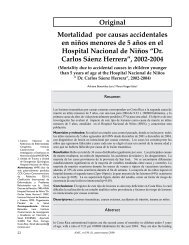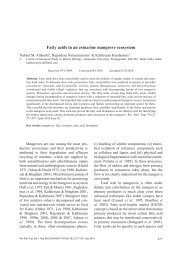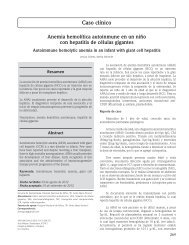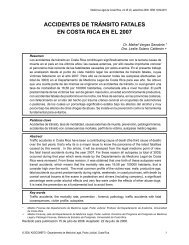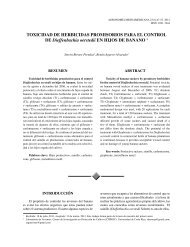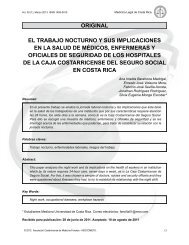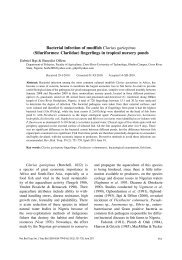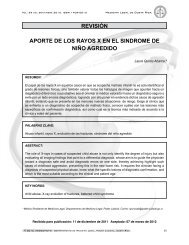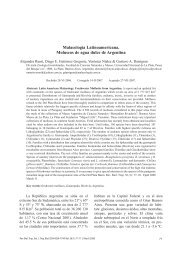Seed germination and seedling growth of two Pseudobombax species
Seed germination and seedling growth of two Pseudobombax species
Seed germination and seedling growth of two Pseudobombax species
Create successful ePaper yourself
Turn your PDF publications into a flip-book with our unique Google optimized e-Paper software.
<strong>of</strong> the Federal University <strong>of</strong> Uberlândia. The<br />
region climate is characterized as Aw according<br />
to the Köppen scale (Köppen 1948), tropical<br />
humid climate with a dry winter (April to September)<br />
<strong>and</strong> rainy summer (October to March)<br />
(Rosa et al. 1991).<br />
<strong>Seed</strong> <strong>germination</strong>: Mature fruits <strong>of</strong> both<br />
<strong>species</strong> were collected in September <strong>and</strong> October<br />
2003. The fruits were collected directly<br />
from the trees <strong>and</strong> placed to dry at room temperature<br />
in order to facilitate the extraction <strong>of</strong><br />
the seeds. <strong>Seed</strong>s were stored in paper bags at<br />
room temperature (between 25 <strong>and</strong> 30°C), in a<br />
dry chamber containing silica gel with humidity<br />
indicator, <strong>and</strong> kept until the installation <strong>of</strong><br />
the experiment, 30 days later. The seeds were<br />
sown on fine vermiculite (expansion volume <strong>of</strong><br />
0.1m 3 ), inside transparent <strong>germination</strong> boxes,<br />
moistened as necessary with distilled water.<br />
Boxes were kept in a <strong>germination</strong> chamber<br />
(<strong>Seed</strong>buro Company, model MDG2000) under<br />
continuous light (mean=11.90, SD=6.52µmol/<br />
m 2 /s <strong>of</strong> photosynthetically active radiation), at<br />
25ºC. The experimental units were r<strong>and</strong>omly<br />
distributed in the <strong>germination</strong> chamber, four<br />
replicates for each <strong>species</strong> with 25 seeds per<br />
replicate. The seed sample size was somewhat<br />
limited as a consequence <strong>of</strong> the high level <strong>of</strong><br />
predation <strong>of</strong> fruits <strong>and</strong> seeds during the collection<br />
year. Although seed samples used for the<br />
experiments were rather small, the data was<br />
still sufficient for consistent statistical tests.<br />
The number <strong>of</strong> germinated seeds was<br />
observed daily <strong>and</strong> protrusion <strong>of</strong> the radicle or<br />
any part <strong>of</strong> the embryo was used as <strong>germination</strong><br />
criterion. Germinability (G), represented<br />
by the percentage <strong>of</strong> <strong>germination</strong> in the experimental<br />
conditions (Labouriau 1983), mean<br />
<strong>germination</strong> time (MGT) ( , Labouriau 1970),<br />
<strong>germination</strong> time to 50% <strong>germination</strong> (GT50),<br />
<strong>germination</strong> time <strong>of</strong> the first germinated seed<br />
(GTFS), <strong>germination</strong> time <strong>of</strong> the last germinated<br />
seed (GTLS), coefficient <strong>of</strong> variation <strong>of</strong><br />
the <strong>germination</strong> time (CVGT) (CV t<br />
, Ranal &<br />
Santana 2006), mean <strong>germination</strong> rate (MGR) (<br />
, Labouriau 1970), uncertainty <strong>of</strong> <strong>germination</strong><br />
(UG) (U, Labouriau & Valadares 1976) <strong>and</strong><br />
synchronization index <strong>of</strong> <strong>germination</strong> (ZG) (Z,<br />
Ranal & Santana 2006 adapted from Primack<br />
1980) were used to describe the <strong>germination</strong><br />
process. Further details on mathematical<br />
expressions, authorship, intermediate calculus,<br />
the sense <strong>and</strong> the applications <strong>of</strong> these <strong>germination</strong><br />
measurements can be found in Ranal &<br />
Santana (2006) <strong>and</strong> Ranal et al. (2009). All germinated<br />
seeds were checked for the presence<br />
<strong>of</strong> more than one embryo per seed, known as<br />
polyembryony <strong>and</strong> common in Bombacoideae<br />
(Mendes-Rodrigues et al. 2005).<br />
<strong>Seed</strong>ling morphology <strong>and</strong> height: <strong>Seed</strong>s<br />
germinated in laboratory conditions were transplanted<br />
to black plastic bags (30cm high per<br />
13cm diameter), filled with previously sieved<br />
open Cerrado oxisol. <strong>Seed</strong>lings were kept in<br />
a greenhouse covered with black plastic net<br />
with 50% shading <strong>and</strong> moistened when necessary.<br />
Starting from emergence date, periodic<br />
measurements <strong>of</strong> the maximum height <strong>of</strong> each<br />
plant, considered from ground to the apex <strong>of</strong> the<br />
last leaf were carried out (Fig. 1 H-1). The data<br />
were adjusted to a linear regression model, as a<br />
function <strong>of</strong> the days from emergence. Some 20<br />
P. longiflorum <strong>seedling</strong>s were evaluated up to<br />
67 days after emergence <strong>and</strong> 15 P. tomentosum<br />
<strong>seedling</strong>s up to 63 days after emergence, when<br />
initial <strong>growth</strong> appeared to stabilize (<strong>seedling</strong>s<br />
showed no further increment in height). The<br />
<strong>seedling</strong> functional morphology was classified<br />
based on Miquel (1987). These <strong>seedling</strong>s were<br />
kept for nine months under the same conditions<br />
to asses a biomass allocation evaluation, as<br />
described below.<br />
Biomass allocation: <strong>Seed</strong>lings for biomass<br />
evaluation were analyzed nine months<br />
after sowing, before foliar abscission started.<br />
Seven plants <strong>of</strong> each <strong>species</strong> were removed<br />
from the soil <strong>and</strong> analyzed for the leaf number<br />
per plant, length <strong>of</strong> the shoot (considered from<br />
the soil to the apex <strong>of</strong> the last leaf) (Fig. 1<br />
H-1), height <strong>of</strong> the apical meristem (from soil<br />
to the apical meristem) (Fig. 1 H-2), height<br />
<strong>of</strong> insertion <strong>of</strong> the first leaf from soil (Fig. 1<br />
H-3), diameter at the shoot base, the largest<br />
Rev. Biol. Trop. (Int. J. Trop. Biol. ISSN-0034-7744) Vol. 59 (4): 1915-1925, December 2011<br />
1917



